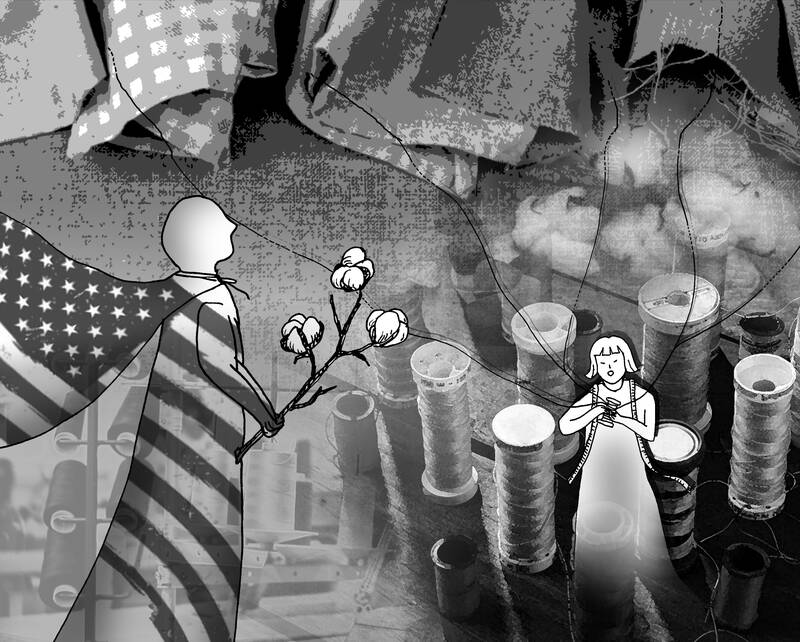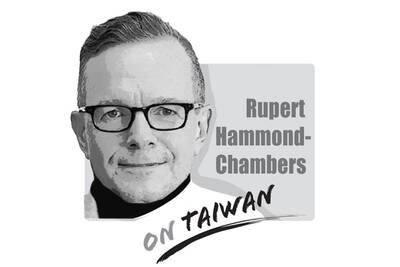With two weeks to avoid US President Donald Trump’s punitive 50 percent tariffs, Indian Prime Minister Narendra Modi has drawn a red line.
India “will never compromise on the interests of its farmers, livestock producers and fisherfolk,” he says.
That commitment is partly dictated by realpolitik. Nearly half of India’s workforce relies on agriculture, a degree of dependence that has increased since the COVID-19 pandemic. It is very hard for a leader to make any concession that appears to let down the very people who have, starting in the 1960s, made the world’s most-populous nation self-sufficient in food and dairy — in the face of tremendous constraints.

Illustration: Tania Chou
However, paeans to the farmer do nothing to alter the harsh economic reality. Even if New Delhi says that a trade war with the US is the price it would pay for shielding growers from a deluge of US corn, soy and cotton, it is not clear that local farmers will be grateful for the protection. The most vulnerable among them will not benefit from it.
Already, international apparel buyers are canceling or suspending orders thanks to Trump’s 50 percent tariff threat. How would India deliver decent returns to farmers on their cotton crop if demand swoons in its biggest overseas market for shirts, pants and T-shirts? Modi wants his fellow citizens to buy things made with the “sweat of our people,” but with a belligerent Washington threatening to upend a vast swathe of local factory jobs, there will be less money at home to buy domestically produced goods. Tamil Nadu’s garment-exports hub in southern India alone is responsible for 1.25 million paychecks.
Losing access to the US consumer might hurt India’s farm economy more than slashing its 39 percent average tariff on imported produce.
In fact, Pakistan might have played Trump better. It has a significant cotton-growing population as well, but last year it became the world’s largest buyer of US cotton, which it imports duty-free. It might take in more now to appease the White House.
India’s textile industry, too, has asked the government to let go of the 11 percent duty on short-staple fiber if it helps sell more of locally manufactured garments at US stores Walmart and Target. After all, this tariff is not really helping the farmer. Domestic cotton production is languishing at a 15-year low, even though 44 percent of the output hitting the market is being scooped up by a state agency at government-assured minimum prices.
The crop in neighboring Pakistan has fared even worse, but at least with a competitive 19 percent tariff, the apparel industry there can hope to expand its market share in the US.
Meanwhile, Indian exporters are staring at a much higher tax — after paying nearly 13 percent more for the main raw material than the prevailing international price.
Cotton is just one example. Domestic prices of most agricultural produce are higher than internationally. While lavish farm subsidies in rich nations make their surpluses globally competitive, New Delhi’s elaborate apparatus of state intervention largely channels the difference between local and international prices toward middlemen. Crop yields are abysmal and climate change is making farm incomes increasingly erratic even behind high trade barriers. The poultry industry is struggling with feed costs, yet tariffs of 45 to 56.5 percent make US soy meal too expensive. If India allows its farmers to grow genetically modified food, they might be able to hold their own against US corn and soybean.
At US$32 billion, agricultural imports are low for a country of 1.4 billion people; and even that figure is padded by palm oil brought in from Indonesia and Malaysia. The US accounts for less than US$2 billion of the total. Why not switch sourcing to US soybean oil and make it duty-free to give Trump a win?
More broadly, why not exploit Trump’s tariff shock to rewire unproductive agriculture and lift stagnant manufacturing? India has 126 million people answering to the description of farmers even though their landholding is about 2 hectares each, a group accounting for 86 percent of all farmers.
As a 2023 survey of marginal producers showed, their 60,000 rupees (US$700) average annual income from selling crops is often less than what they earn from a second occupation as daily-wage labor. They are stuck on the land because of food security — and because the urban economy has nothing for them.
About one in 10 families has someone in a salaried job and only one-third of those farmers take advantage of state procurement at pre-announced prices. Others sell to private traders. The most popular government support program for the group is straight-up cash in bank accounts; it would stop if they were no longer holding on to the land.
Yet the taxpayer is picking up the bills for keeping the land cultivated when imports would be cheaper; and for shielding urban workers from the high costs of locally grown produce. Lest expensive food crush the country’s dream of industrialization, the government gives free rice and wheat to 800 million people so that their employers do not have to pay them high wages.
Throw everything into the mix, and the annual cost was in excess of US$100 billion during the pandemic. If the tariff-related disruption turns out to be worse than COVID-19, as some exporters fear, then the fiscal drag might only become heavier.
Four years ago, Modi was forced to withdraw legislation that had a basic premise of giving farmers more freedom to discover free-market prices. If that was a poorly designed makeover, striking a defiant note against a mercurial US president in the name of agricultural interests is also ill-conceived.
However, with the prime minister’s political opponents stepping up their campaign against his 11-year-old rule, it is irrational to expect meaningful reforms. Politics will triumph over economics.
Andy Mukherjee is a Bloomberg Opinion columnist covering industrial companies and financial services in Asia. Previously, he worked for Reuters, the Straits Times and Bloomberg News. This column reflects the personal views of the author and does not necessarily reflect the opinion of the editorial board or Bloomberg LP and its owners.
Having lived through former British prime minister Boris Johnson’s tumultuous and scandal-ridden administration, the last place I had expected to come face-to-face with “Mr Brexit” was in a hotel ballroom in Taipei. Should I have been so surprised? Over the past few years, Taiwan has unfortunately become the destination of choice for washed-up Western politicians to turn up long after their political careers have ended, making grandiose speeches in exchange for extraordinarily large paychecks far exceeding the annual salary of all but the wealthiest of Taiwan’s business tycoons. Taiwan’s pursuit of bygone politicians with little to no influence in their home
In a recent essay, “How Taiwan Lost Trump,” a former adviser to US President Donald Trump, Christian Whiton, accuses Taiwan of diplomatic incompetence — claiming Taipei failed to reach out to Trump, botched trade negotiations and mishandled its defense posture. Whiton’s narrative overlooks a fundamental truth: Taiwan was never in a position to “win” Trump’s favor in the first place. The playing field was asymmetrical from the outset, dominated by a transactional US president on one side and the looming threat of Chinese coercion on the other. From the outset of his second term, which began in January, Trump reaffirmed his
It is difficult not to agree with a few points stated by Christian Whiton in his article, “How Taiwan Lost Trump,” and yet the main idea is flawed. I am a Polish journalist who considers Taiwan her second home. I am conservative, and I might disagree with some social changes being promoted in Taiwan right now, especially the push for progressiveness backed by leftists from the West — we need to clean up our mess before blaming the Taiwanese. However, I would never think that those issues should dominate the West’s judgement of Taiwan’s geopolitical importance. The question is not whether

In 2025, it is easy to believe that Taiwan has always played a central role in various assessments of global national interests. But that is a mistaken belief. Taiwan’s position in the world and the international support it presently enjoys are relatively new and remain highly vulnerable to challenges from China. In the early 2000s, the George W. Bush Administration had plans to elevate bilateral relations and to boost Taiwan’s defense. It designated Taiwan as a non-NATO ally, and in 2001 made available to Taiwan a significant package of arms to enhance the island’s defenses including the submarines it long sought.